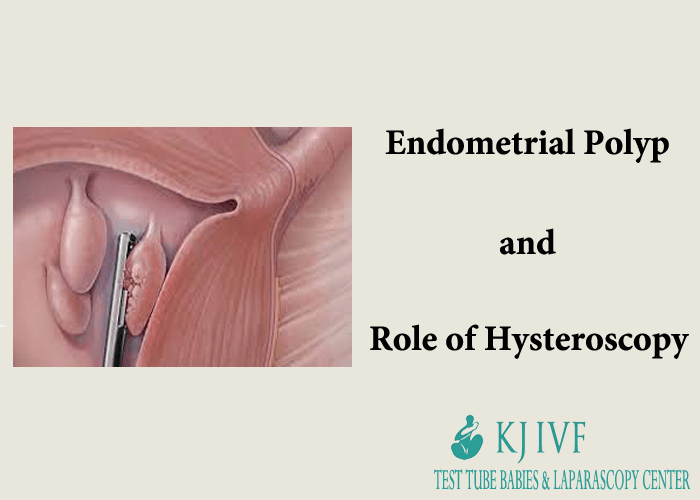
Endometrial Polyp and Role of Hysteroscopy
An endometrial polyp is an overgrowth of endometrial tissue in uterus (endometrium is the inner lining of uterus). Endometrial polyps are often small growths attached to the uterine wall by a stalk. Endometrial polyps are made of tissue that is more responsive to hormone estrogen.
It is estimated that endometrial polyps are found in 10% of general female population. In females with infertility, polyps are found in upto 45% of patients while in cases of abnormal uterine bleeding polyps are seen in 25% to 30% of patients. Polyps may cause abnormal uterine bleeding, recurrent miscarriage and infertility, though their relationship to infertility is controversial.
What are the Effects of Endometrial Polyps on Reproduction?
Endometrial polyps have been associated with the decreased pregnancy rates and increased miscarriage rates. They are thought to interfere with the sperm transport as well as embryo implantation. Basic science studies have demonstrated the chronic inflammation in the endometrial tissue that surrounds endometrial polyps. There are studies that have shown improved pregnancy rates and the decreased miscarriage rates after endometrial polyps have been removed.
How are Endometrial Polyps Diagnosed?
There are several methods to diagnose uterine polyps.
- In a Hysterosalpingogram (HSG) doctor ( a radiologist) injects dye into the uterus and fallopian tubes in order to outline different reproductive tract organs and to determine the presence of any pathology including polyps.Polyps will be seen as filling defects.
- A Hysteroscopy is a procedure in which a doctor inserts a telescope through the vagina and into the uterus to examine the uterine cavity from inside.Polyps can be seen as small masses hanging from the uterine wall.
- By inserting instruments through the hysteroscopic tube, a doctor can also take polyp samples for examination under a microscope, called biopsyl.
- A Transvaginal Ultrasound can create images of the uterine cavity and help identify polyps. For this technique, a doctor inserts a probe into the vagina and high-frequency sound waves from the probe then project images of the uterine area on a monitor. A TVS alone is not a sensitive method of diagnosing polyps.
- Saline Infusion Sonography is a similar procedure in which a radiologist injects a saline solution into the uterine cavity in order to inflate the uterus like a balloon. This approach reveals polyps that may have been overlooked in a standard ultrasound.
Treatment of Endometrial Polyp
Treatment of endometrial polyp depends on the associated symptoms and age of the woman. In premenopausal women, small asymptomatic polyps can be left as such for expectant treatment. However in postmenopausal women, polyps should be removed.
In symptomatic women, polyps must be removed when they are causing abnormal uterine bleeding or recurrent miscarriages.
In women with infertility and endometrial polyp, management of endometrial SS polyps is controversial. As they are seen in up to 45 % women with infertility, they must be removed. Also, in women with recurrent implantation failure, polyps must be removed.
Role of Hysteroscopy
Hysteroscopy can also be used to treat polyps. A hysteroscope is a telescope that is inserted into the uterine cavity through vagina. Uterine cavity is inflated with fluid to visulaise the cavity and identify pathology like polyps. Instruments can be inserted in to the uterine cavity through the same channel and polyp can be resected under vision. Hysteroscopic elimination of polup is a better way to deal with it than blind curettage.
Why KJIVF for Hysteroscopy
- First IVF and Laparoscopy Center of East Delhi, India – 25 years of quality care.
- Premium and only teaching ART Center of East Delhi, Delhi NCR, India.
- Comfortable post op recovery period. No additional bed rest or compromise of the routine activities.
- Affordable compared with the rest, we have reasonable hysteroscopy costs & pricing.
- Complete transparency is our key concern and through the counselling to help you decide the right treatment.
- Even in obliterated uterus cavity, we offer the corrective surgery and restoration the cavity up to 80%. So it gives good results.
- Highly trained consultants.
- Ethical practice/No false claims.
- Individualized care and treatment.
- All basic and advanced facilities under one roof.
- Individual protocols to make the whole treatment affordable and cost effective.
For more queries, Call us at +91 9650725386, 011 3560 4368.
Our Related Searches:-
Hysteroscopy Treatment in Delhi, Hysteroscopy Surgeon Delhi, Hysteroscopy Cost In Delhi, Hysteroscopy Surgery Cost in Delhi, Hysteroscopies Doctors In Delhi, Hysteroscopy Treatment in Faridabad, Hysteroscopy Surgeon Faridabad, Hysteroscopy Cost In Faridabad, Hysteroscopy Surgery Cost in Faridabad, Hysteroscopies Doctors In Faridabad, Hysteroscopy Treatment in India, Hysteroscopy Surgeon India, Hysteroscopy Cost In India, Hysteroscopy Surgery Cost in India, Hysteroscopies Doctors In India.
